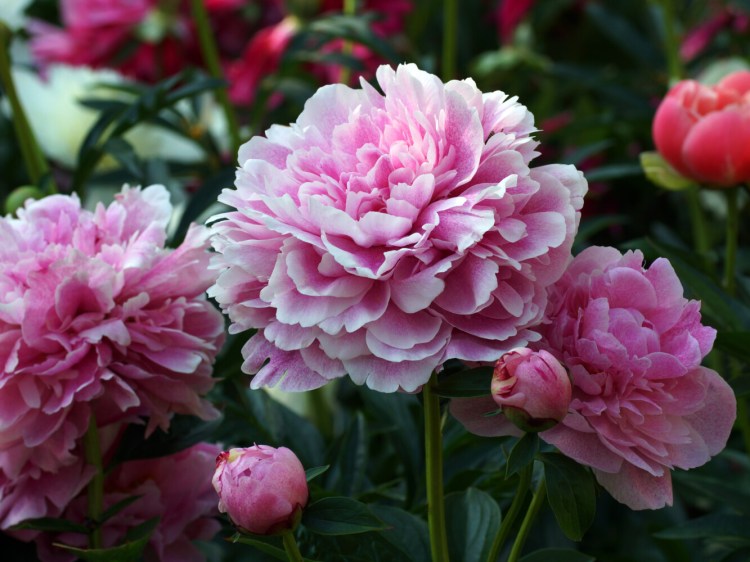This is going to be a wonderful year for peonies, and I think my wife Nancy and I deserve it.

Anticipation: Buds on columnist Tom Atwell’s newly planted peonies earlier this month. Photo by Tom Atwell
We’ve been watching the development of a major planting we did in the autumn of 2021 when we pulled out a bird’s nest spruce (that’s a tree, not a bird’s nest) that had grown as tall as Nancy. First, I tried cutting back the spruce but, trust me on this, it was a waste of time. Too many visitors asked what happened to that poor evergreen. So I dug it out, and we replaced it with peonies – lots of them. This is the first year they will begin to show what they can do.
If you are inspired by this article to grow peonies of your own, I’m sorry – you should probably wait until fall. While you can buy potted peonies now at your local garden center – we have done that – the plants do better when they are planted as roots in the fall: They get larger more quickly and bloom earlier.
The first peonies we ever planted on our property came from the property of Nancy’s grandmother, where they grew gloriously in a spot with full sun and never needed any support. Each spring, Nancy reminisces about those plants as she puts supports of various types on our peonies. Ours are floppers, because they get at most six hours of sun per day.
Peonies come in the entire rainbow of colors – red, pink, yellow, white and purple. We have planted a wide mix. And it isn’t just the flowers that are attractive. I was pleased with the vibrant maroon shoots that came up in April, at the same time the crocus and hyacinth were blooming. Any color at that time of year is a blessing.
When I say peony, don’t think I am talking about just one species of plant. There are several – related but still quite different.
Woodland peonies bloom first. They are white and take more shade than most other peonies. Ours blossomed on May 19 this year, and it was a thrill to see. In the fall, the plants will get red seed pods that add to their attractiveness.
The second to bloom are tree peonies, which, despite the name, aren’t trees, but rather shrubs that grow extremely slowly. Unlike other peonies, these should not be cut down in the fall. Ours has been planted for close to a decade and is only about 3 feet tall, so far. It could grow to be 7 feet, but I doubt I will live long enough to see that, especially here in Maine,
The most common type are the herbaceous peonies, which are what we’ve planted to replace spruce. Although I hope they will look good this year, I remember hearing Kathleen Gagan, of Peony’s Envy Flower Farm in New Jersey, speaking at the Maine Flower Show in 2019. She said it takes seven years for them to reach their peak.

A few peony blossoms in Tom Atwell’s garden in late June, 2022. Photo by Tom Atwell
The herbaceous peonies usually flop if they don’t get enough sun – and sometimes even if they do. The solution is peony hoops, which come in many types.
The ones we like best are L-shaped brackets, with loops on top of the L and a 3-inch “hook” at the other side of the top. Just as the peonies have sprouted, you connect three or more of the brackets together (hook into loop and so on), depending on how large the peony is, supporting the stems as they grower taller and buds turn into blooms.
The newest, latest-blooming and usually most expensive peonies are Itoh or intersectional peonies, which were created in 1948 when a botanist (named Toichi Itoh) hybridized herbaceous and tree peonies. Itoh peonies will produce more blossoms that last a longer time than any of the other peony varieties.
Ideally, you (or whoever follows you in the garden) will leave your peonies alone for a century, so they will keep getting larger and produce more blossoms. But they may outgrow their space, or you may want to share your bounty. If you plan to move them, do so in the fall.
Starting about a foot outside the farthest stem, dig a foot deep all around the plant. When I moved ours two years ago, I started with a shovel and switched to a trowel to go under the roots. Carefully remove the entire plant. Wash the roots, so you can see what you are doing. Cut the crown of the plant so each piece has three to five buds and at least one strong, tuberous root. Loosen the soil where you will be planting them, add a bit of ground limestone to make the soil alkaline, and place the root so the buds are just below the surface of the soil. Add compost to enrich your soil, and remember it’s going to be there for the rest of your life.
The next part is the toughest. Wait patiently. If we get blooms on our transplanted peonies this year (As I write this, I can already see buds!), I’ll post photos on my Facebook page.
Tom Atwell is a freelance writer gardening in Cape Elizabeth. He can be contacted at: tomatwell@me.com.
Send questions/comments to the editors.



Comments are no longer available on this story